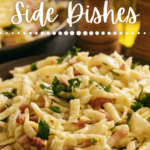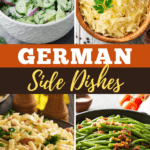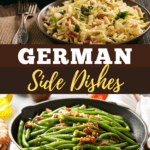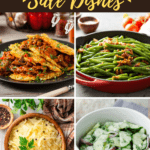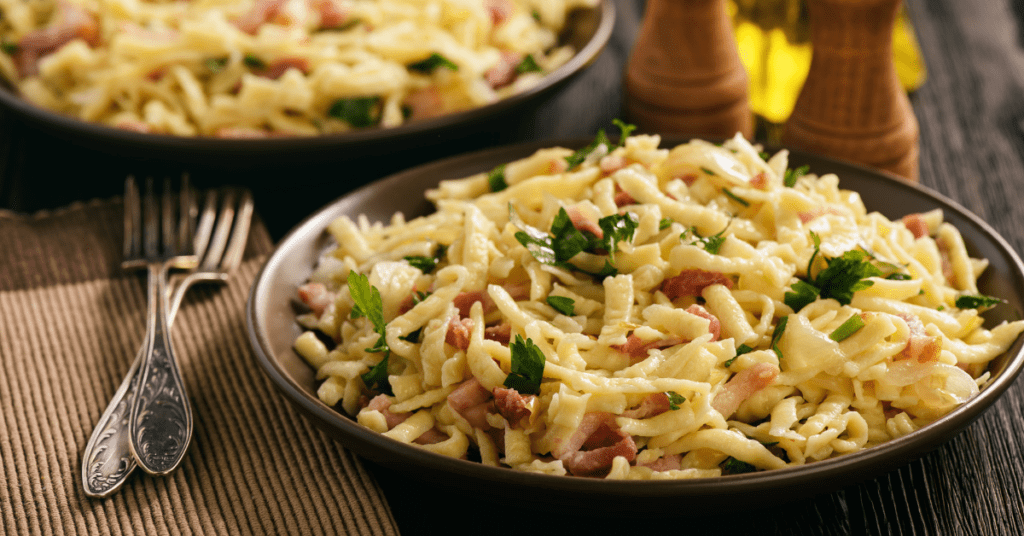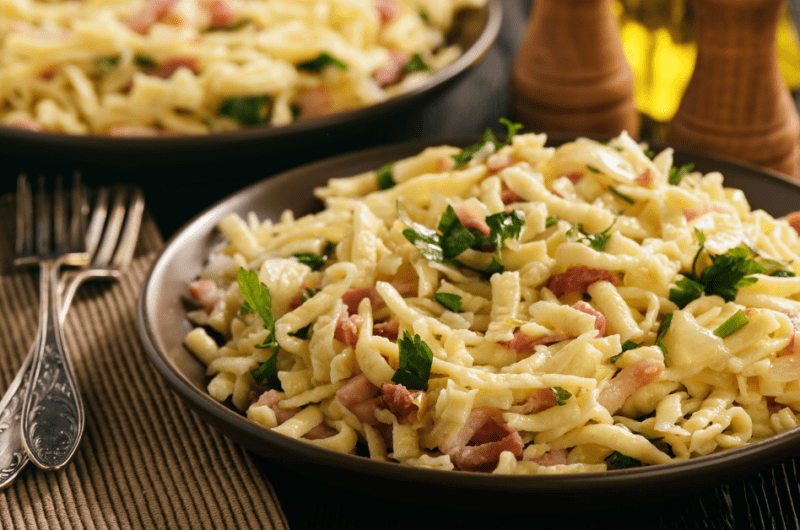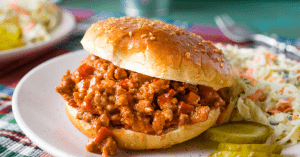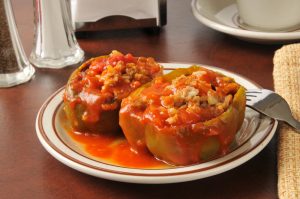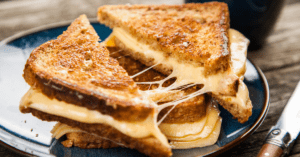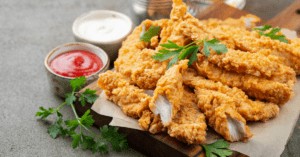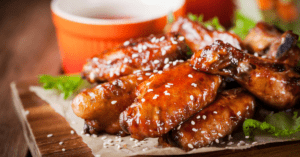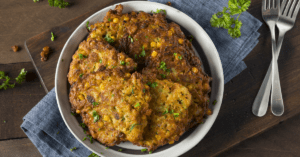Whether you’re hosting a big party or an intimate gathering, you should obviously give importance to your main course. But you also don’t want to take side dishes for granted. Sure, they may not be the star of the meal, but they’ll make your party an even bigger hit. If it’s an Oktoberfest or a German-inspired celebration you want, you’ve come to the right place. Whether you are serving, schnitzel, Schweinshaxe, smoked chops, or sausages, the key is to pick sides that offer the right flavor and texture combinations. Don’t worry, because I’m here to walk you through the best German side dishes there are. Join me on this fun journey!
1. Bratkartoffeln (Fried Potatoes)
Germans love their potatoes. In fact, potatoes are a classic part of any German meal. German potatoes are a lot similar to red potatoes, which are smooth and creamy, unlike Idaho Russet potatoes. Since the 17th century, potatoes have become such a regular staple in both German and Austrian cuisines. There are a myriad of potato-based side dishes, such as bratkartoffeln, or pan-fried potatoes. The potatoes are either sliced into wedges or diced, boiled, deep-fried, and seasoned with salt and pepper. They may be served as is, or mixed with bacon, ham, onions, vegetables, and seasonings, herbs and spices. Bratkartoffeln is a popular side dish for both home-cooked and restaurant meals. They’re typically served on the side of sausages, meat, fish, and eggs.
2. Kartoffelbrei (Mashed Potatoes)
Next up on our list of German potato sides is the kartoffelbrei, or mashed potatoes. They don’t have the same level of fame as bratkartoffeln, but they’re just as tasty. German mashed potatoes are whipped vigorously to achieve that smooth and silky consistency and are loaded with butter and heavy cream for a rich flavor. They’re sprinkled with chopped parsley for a pop of color and added flavor.
3. Kroketten (Also Mashed Potatoes)
Kroketten are breadcrumb-coated, then deep-fried mashed potatoes. From that description alone, you can already tell how rich and hearty this side dish is!
4. Himmel und Erde (yet another version of Mashed Potatoes)
The term himmel and urde literally means heaven and earth. It’s another variation of mashed potatoes, where the creamy side is paired with apple sauce. While it’s traditionally served as a side for blood sausage (in that case, it’s called himmel, erde, un höllen, meaning heaven, earth, and hell), others also use it to accompany various meat dishes.
5. Kartoffelsalat (Potato Salad)
Kartoffelsalat, or the German potato salad, is another classic side dish in German cuisine. It’s not the same as the American potato salad we know and love, though. For starters, the potatoes need not be peeled for this dish. And unlike the mayo-based dish we’re all used to, this one has a thick, tangy dressing made with vinegar and bacon grease. Also, it’s served warm as opposed to chilled. Kartoffelsalat is best served with bratwurst.
6. Pellkartoffeln (Boiled Potatoes)
Pellkartoffeln is another potato dish that involves boiled potatoes with their skins intact. Leaving the skins on makes the dish more flavorful and nutritious. The potatoes are rinsed and scrubbed well to get rid of dirt and impurities before being boiled in salted water with bay leaves or caraway seeds. They may either be eaten as is or mixed with lots of butter. They may also be paired with kräuterquark, which is quark (a type of cheese) infused with fresh herbs; Lachs Remoulade or salmon remoulade; heringssalat or red herring salad; leberwurst or liverwurst; or curry sauce. Last, pellkartoffeln is also used as the base of other German potato sides featured on this list, such as the bratkartoffeln and the kartoffelsalat.
7. Salzkartoffeln (Also Boiled Potatoes)
This is basically a variation of the pellkartoffeln, where the potatoes are boiled with water infused with salt and parsley. The smooth and silky side dish is more often served with fish and other light main dishes.
8. Kartoffelpuffer (Potato Pancakes)
Kartoffelpuffer (which, by the way, is so fun to say) is a German potato pancake. The ubiquitous side dish is not only a staple at home, but is also a popular restaurant and street food offering. The potato pancakes are made with shredded raw potatoes, flour, and eggs. Much like regular pancakes, the batter is shaped into round discs and pan-fried until golden. Kartoffelpuffer is so versatile, it may be served either as a side to meats, sausages, and stews; or as the star of the meal, paired with sour cream, fruits, preserves, or applesauce.
9. Klösse (Potato Balls)
These savory, bite-sized potato balls are another popular German side dish. Klösse is made by combining shredded and mashed potatoes, which are then boiled and shaped into balls. Perhaps every region in Germany has its own version of this well-loved side. One of them (the Thüringer Kloß) has croutons in the middle. Klosse are best served with meat and gravy, as they do a fine job of soaking up gravy, giving them more flavor.
10. Pommes (French Fries)
Pommes, or German French fries (or should I say German fries?) are the most popular street food side in Germany. This crunchy classic is most commonly served on the side of the schnitzel, a battered and fried meat.
11. Cheese Spread
Okay, a cheese spread may not be inherently German, but this recipe sure makes a wonderful topping for brats and pretzels! To make it, you’ll need cubed sharp cheddar cheese, beer, Worcestershire sauce, mustard, garlic, salt, and pepper. Just pulse all those ingredients together in a blender until you form a thick and smooth mixture. Yum!
12. Gurkensalat (German Cucumber Salad)
Gurkensalat or German cucumber salad is a creamy yet refreshing side made with red/purple onions, sour cream, sugar, vinegar, dill, and of course, the star – thinly sliced cucumbers. It makes a wonderful side to meats such as steak, chicken, and burgers. It may be a completely German dish, but it’s great to serve for 4th of July barbecues! It’s perfect for potlucks, picnics, and backyard parties, too! It’s very easy to make, as well. All you do is mix all the ingredients together and you’re done. Refrigerate it for at least 4 hours to allow the cucumbers to absorb the flavors of the other components. Don’t skip this part, as it’s the key to the best-tasting gurkensalat.
13. Nudeln (Noodles)
Noodles are just as popular in Germany as they are in Italian and Asian cuisines. Called the nudeln, they’re typically served with sauces and meats.
14. Spaetzle (Pasta)
Spaetzle is a type of pasta that originates from Swabia, Germany. There are many versions of spaetzle, but all of them involve flour, eggs, milk, and salt. Shapes and sizes vary from long and thin to short and fat. In Swabia, the noodles are often formed by pushing the dough through the holes of a colander and then dropped in boiling water, forming dumpling-sized pasta. The noodles are then coated in butter for flavor. They may be eaten as is or topped with sauces, cheese, meats, and herbs.
15. Knödel (Dumplings)
The Knodel is a German dumpling that is usually made with either flour, day-old bread, or potatoes. They are either boiled or steamed and are served with meats and soups. There are various varieties of the knodel, including the knedle, which is a plum-filled dumpling.
Semmelknödel
Semmelknodel is perhaps the most common and versatile variety of dumplings. They’re made with stale bread, such as rolls, pretzels, or baguettes. They’re softened with hot milk and mixed with egg, parsley, nutmeg, onions, and salt and pepper. They may be served as is or pan-fried until golden brown. They’re commonly served during Christmas or other special occasions as an accompaniment to roasts, gravy, mushroom sauce, lentils, roulades, and goulash. Fun fact: the semmelknödel is also called the serviettenknödel, meaning napkin dumplings, because they’re traditionally steamed inside a cloth napkin (serviette). Today, however, they’re more commonly cooked in aluminum foil and plastic wrap.
Kartoffelklöße or Kartoffelknödel
This variation of the knödel is most popular in Thuringia, Rhineland, and Bavaria. These dumplings are made with raw or cooked potatoes, or both.
16. Sauerkraut
This is perhaps the most famous German side there is. Sauerkraut is a tangy side dish made with fermented cabbage. Because of its pungent flavor, this dish is an acquired taste that works well with meats and sausages. It’s also often added to sandwiches and casseroles. Did you know that sauerkraut is great for the body, too? It’s loaded with vitamins and even contains the same type of good bacteria you’ll get from yogurt. Here’s another fun fact: while it’s undoubtedly German, the idea of fermenting cabbage isn’t inherently theirs. In ancient China, people used to ferment shredded cabbage in rice wine. Germans, on the other hand, use salt water instead of wine.
17. Grüne Bohnen (German Green Beans)
This simple side dish comprises blanched German green beans and breadcrumbs fried in butter. It may sound like an unlikely pairing, but the fried breadcrumbs give the beans a rich buttery flavor and crunchy texture.
18. Pretzels
The pretzel is a German pastry famous for its shape. The distinct knot is formed by twisting and intertwining a long strip of dough. The two most common varieties of the pretzel include long-lasting hard-baked pretzels and soft pretzels, which are best eaten right away. Pretzels are traditionally flavored with just salt, but modern versions use other seasonings such as chocolate, cheese, caramel, sugar and cinnamon, glazes, nuts, seeds, and more. While it seems like an intimidating pastry, it’s not that complicated. All you need are flour, brown sugar, active dry yeast, and water, a mixer, and an oven.
19. Rotkohl (German Red Cabbage)
Rotkohl is a side dish made with sauteed red cabbage, shredded apples, and onions. The ingredients are then drenched in dark red wine, which is then reduced to get a thick and tasty sauce. It has a similar flavor as the sauerkraut but is not as tangy and pungent. The side dish tastes best with savory meats, sausages, and pasta.
20. Leipziger Allerlei (Mixed Vegetables)
This side dish originated from Leipzig, Germany, and comprises mixed veggies, including asparagus, kohlrabi, peas, carrots, and cauliflower. It’s then combined with crawfish tails, morel mushrooms, and bread dumplings. The ingredients are then drenched in a rich and buttery sauce. To finish it off, it’s topped with freshly chopped parsley. It may be eaten as a side dish or as a main course. Click on a star to rate it!
Average rating 5 / 5. Vote count: 3 No votes so far! Be the first to rate this post.
Share on social media: Let us improve this post!
